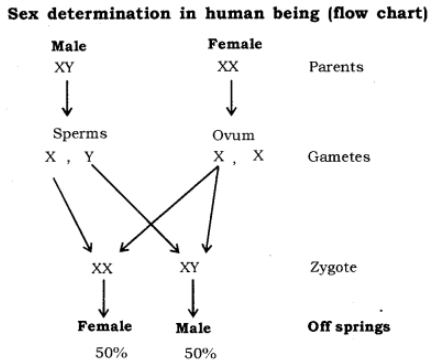
Who decides the sex of the baby, mother or the father? Explain with a flow chart.
Answer
556.5k+ views
Hint:Humans have 23 pairs of chromosomes. Of these, 22 are the autosomes, and the 23rd pair constitutes the sex chromosomes X and Y. Males are 22 XY and females are 22 XX.
Complete answer:
During gametogenesis, the diploid cells undergo meiotic cell division to produce haploid gametes. In the female these are the egg cells, and in the male, the sperm cells. The female gametes will be produced from cells that are 22XX. So all the egg cells or ova will contain the X chromosome.
The male gametes are produced from the cells which are XY. So sperm cells can be either 22X or 22Y haploid cells. During fertilisation the egg cell and sperm cell fuse to form the diploid zygote. If a 22 X egg fuses with a 22 X sperm, the zygote will be the diploid 22 XX. However, if the 22X egg cell fuses with the 22Y sperm cell, then the zygote will be diploid 22 XY.
Therefore, depending on which type of male gamete or sperm cell fertilises the egg cell or ovum, the resulting zygote will either develop into a female (XX) or male (XY). There is a 50% probability of either event happening, but whichever it is, the choice of male gamete decides what the sex of the baby will ultimately be. The presence of the Y chromosome is required for maleness. An individual with Turner’s Syndrome, who is 22 XO, will still be female though she would miss some of the secondary sexual characteristics.

Note:While man has the XY system to determine gender, it is not the same throughout the entire animal kingdom. For instance in birds males are ZZ while females are the heterogametic sex, designated ZW.
Complete answer:
During gametogenesis, the diploid cells undergo meiotic cell division to produce haploid gametes. In the female these are the egg cells, and in the male, the sperm cells. The female gametes will be produced from cells that are 22XX. So all the egg cells or ova will contain the X chromosome.
The male gametes are produced from the cells which are XY. So sperm cells can be either 22X or 22Y haploid cells. During fertilisation the egg cell and sperm cell fuse to form the diploid zygote. If a 22 X egg fuses with a 22 X sperm, the zygote will be the diploid 22 XX. However, if the 22X egg cell fuses with the 22Y sperm cell, then the zygote will be diploid 22 XY.
Therefore, depending on which type of male gamete or sperm cell fertilises the egg cell or ovum, the resulting zygote will either develop into a female (XX) or male (XY). There is a 50% probability of either event happening, but whichever it is, the choice of male gamete decides what the sex of the baby will ultimately be. The presence of the Y chromosome is required for maleness. An individual with Turner’s Syndrome, who is 22 XO, will still be female though she would miss some of the secondary sexual characteristics.

Note:While man has the XY system to determine gender, it is not the same throughout the entire animal kingdom. For instance in birds males are ZZ while females are the heterogametic sex, designated ZW.
Recently Updated Pages
Why is there a time difference of about 5 hours between class 10 social science CBSE

In cricket, what is a "pink ball" primarily used for?

In cricket, what is the "new ball" phase?

In cricket, what is a "death over"?

What is the "Powerplay" in T20 cricket?

In cricket, what is a "super over"?

Trending doubts
What are the major means of transport Explain each class 12 social science CBSE

Which are the Top 10 Largest Countries of the World?

Draw a labelled sketch of the human eye class 12 physics CBSE

How much time does it take to bleed after eating p class 12 biology CBSE

Explain sex determination in humans with line diag class 12 biology CBSE

Explain sex determination in humans with the help of class 12 biology CBSE




